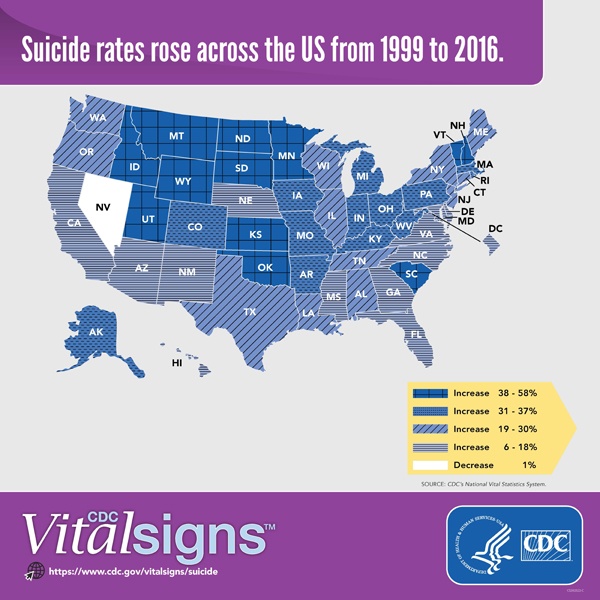Being Proactive about Behavioral Health
Based on our clients’ major initiatives, we’ve seen an increase in employee and patient engagement wellness projects on our platform over the last six months. These projects mainly focus on the physical well-being of a given population, but what about mental health initiatives?
With the high-profile suicides of celebrities such as Kate Spade, Anthony Bourdain, and Robin Williams, there is increased concern about mental well-being and its role in overall health and wellness. It’s also very likely that we all have been touched personally by suicide: rates are up 25% since 1999, and suicide is now a top 10 cause of death in the United States. While we’re willing to help our loved ones who are struggling, symptoms are often hidden to seem ‘normal’ and avoided to ‘not feel like a burden.’ Furthermore, 54% of suicide victims have no report of prior mental illness.
This begs the question – how can we make those in need of mental health help feel more comfortable about seeking assistance?
We’ve seen a trend towards proactive mental health engagement projects. These projects include digital depression care, applications that connect patients to behavioral health providers (including multilingual providers) through telemedicine solutions, and overall emotional wellness.
Increasing Access to Mental Health Assistance
Digital resources for individuals wanting to be more proactive about their mental health have increased in availability. The emerging mental health apps range from simple mindfulness and meditation to remote sessions with a licensed provider (via telehealth). These resources are also preferable for a public that is increasingly turning to their digital devices rather than in person interactions. Plus, one of the benefits is that they are easily accessible 24/7 with an immediate ‘lifeline’ (because timing is crucial in such situations).
The idea of digital solutions to increase access is particularly appealing to younger demographics, which tend to lack access to qualified providers. This is an important consideration, with only 35 % of adults 18 to 25 seeking treatment for mental illness.
There are 2 common barriers to seeking needed mental health treatment: the associated stigma and the steep expense. The increased access through digital resources could help with one or both of these concerns.
Untreated mental illnesses cost the U.S. at least $105 billion in lost productivity annually, according research by Harvard University Medical School, largely the result of 35 million lost workdays every year, according to a study by Mercer.
According to a paper by Colton and Manderscheid, PhD, individuals living with serious mental illness also face an increased risk of having chronic medical conditions and higher mortality rates.
With almost half of those adults lacking access to routine treatment, the onus is on all of us to make this conversation acceptable and welcome. As friends, family, and employers, this issue touches all of us.
Despite the excitement and ease of access for patients, studies are still divided if these digital behavioral resources can replace working with a licensed mental health provider, outcomes suggest that resources like apps can augment work that’s done in therapy. While there are champions for and against mental health management technologies, all the experts agree- digital supplements are not a replacement for treatment by a licensed provider, especially when suicidal thoughts are experienced.
Finding the Best Behavioral Health Solutions
Are you a provider looking to implement a behavioral wellness program? Click here for our Jumpstart Guide.
YOU MATTER.
If you need help for yourself or someone else, please contact the National Suicide Prevention Lifeline:
Talk: 1-800-273-TALK (8255)
Chat: www.suicidepreventionlifeline.org
The Valify Editorial Team is dedicated to sharing insights, strategies, and innovations that help healthcare organizations gain control of purchased services spend. Backed by years of expertise in data analytics, procurement, and healthcare technology, the team curates practical resources and thought leadership to guide hospitals and health systems toward greater efficiency and savings. By combining industry knowledge with real-world case studies, the Valify Editorial Team delivers content that empowers decision-makers to drive smarter, data-driven sourcing strategies.

